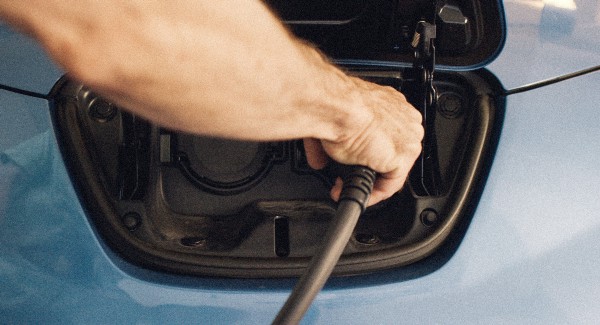Going solar is one of the best and most popular ways to enlist your home in the clean energy revolution, with the U.S. residential solar market topping 2 gigawatts of new capacity in 2015 for the first time ever. But in 2016, the clean energy conversation includes a growing range of technologies to make your home greener — and smarter — than ever. Nowadays a clean energy dream home might also have a battery storage system to work with those solar panels, an electric vehicle in the garage, and a wide range of smart home systems inside to make everything work together seamlessly and efficiently.
Battery Storage
You’ve probably heard a familiar complaint about solar from renewable energy skeptics: it only works when the sun is shining. That hasn’t stopped it from replacing lots of dirty fossil fuel generation and saving homeowners money on their electricity bills, but the ability to store solar power for use anytime is still a potential game-changer. It could help grid operators manage solar resources more easily, reduce demand during early evening peak hours, and potentially even allow consumers to disconnect from the grid altogether and rely on their own solar power all day and night!
There are almost as many ways to store electricity as there are ways to generate it, but the technology of choice for home clean energy storage is lithium-ion batteries — the same kind that power cell phones and laptops. These battery cells are assembled into systems that can perform a range of functions depending on their size and design. Entry-level units may store just enough energy to help avoid peak demand charges and/or save solar power for use when electricity is most expensive. Larger and more robust battery systems may have “islanding” capability — the ability to function as a stand-alone system without a grid connection — and sufficient storage to meet all of your energy needs in case of an emergency.
With the costs of batteries falling almost as fast as the costs of solar panels, a growing number of companies are beginning to offer clean energy home storage systems designed for use in combination with residential solar generation. This year has already seen a number of new products introduced for this market in the U.S., with leading companies including Sonnen and Tesla. Speaking of Tesla…
Electric Vehicles
While gasoline-fueled cars were undoubtedly an iconic part of American life in the 20th century, electric vehicles (EVs) are making a strong case for becoming the 21st century’s favorite transportation technology. All-electric vehicles produce zero harmful pollution from their non-existent tailpipes, and their lifecycle greenhouse gas emissions are more than 50% lower than a gasoline vehicle on average — or 100% lower if you’re charging with renewable energy! Moreover, lots of drivers are finding that the fast acceleration, smooth handling, and quiet operation of EVs make them a better choice regardless of how you feel about the environment.

While EVs are still only a small portion of overall car sales in the U.S., that fraction is expected to grow as automakers introduce more models. According to the most recent data from EV Obsession, there are currently 12 EV models for sale in the U.S., led by Tesla’s Model S and Model X, the Nissan Leaf, and the BMW i3. There are also 16 plug-in hybrid electric vehicle (PHEVs) models available that run on electricity but can also fuel on gasoline when needed, with top sellers including the Chevy Volt from GM and Ford’s Fusion Energi and C-Max Energi.
Public EV charging networks are popping up at gas stations, office spaces, retail stores, and other locations, with over 16,000 public charging stations around the country. However, most drivers charge more than 80% of the time at home, which makes a dedicated EV charger in your garage an essential part of any clean energy dream home.
Smart Home
The proliferation of technology choices we face every day can already seem overwhelming, so it’s natural to wonder if adding a new layer of home clean energy gear could make things even more complicated. Happily, much like our smart phones and smart watches, clean energy technology today is smart enough to enable your solar panels, battery storage system, and electric vehicle to “talk” to each other and automatically coordinate their operation for maximum savings and minimum hassle.
The “smartening” of your home energy use doesn’t end there. A true clean energy dream home will include a growing number of household appliances that can communicate with homeowners and each other to operate harmoniously with your lifestyle as well as the environment. For example, smart thermostats can ensure your house is at your preferred temperature when you’re at home while eliminating wasted energy when you’re out, and smart dishwashers and washing machines can automatically take care of the cleaning when electricity prices are lowest. Of course, like everything else in your life, these smart appliances can be managed via phone apps, so you can check your energy use (and savings) as easily as you check Twitter.
Heavy hitters in home appliances like GE and Whirlpool are busy equipping their new products with these kinds of smart features, and potential synergies are attracting software and home electronics companies like Google and Samsung as well. While it may be awhile before we replace all of our “dumb” appliances, they might seem as old-fashioned as VCRs and cassette players sooner than you think.
Putting It All Together
It would seem like science fiction just a few years ago, but today it’s not unheard of for a bright-green homeowner to have solar panels that generate clean electricity for their zero-emission electric vehicle, a battery pack to store and manage excess energy, and smart home systems that make everything work together smoothly. Of course, like solar panels, these technologies require significant up-front investments, and financing will play a big role in making the clean energy dream home a reality for most homeowners… But that’s a subject for a future post.
